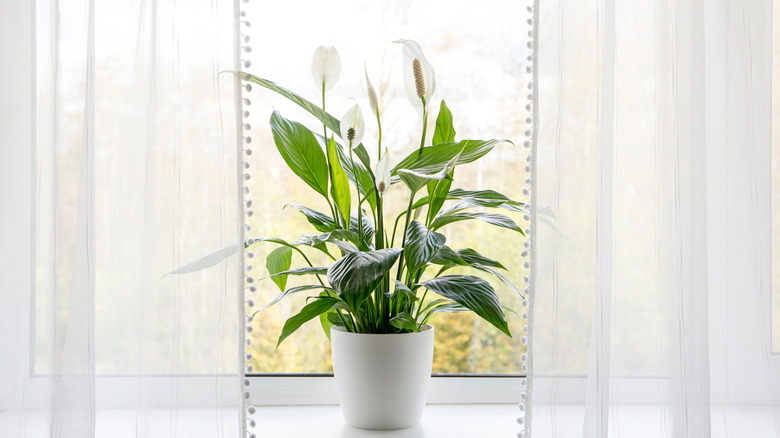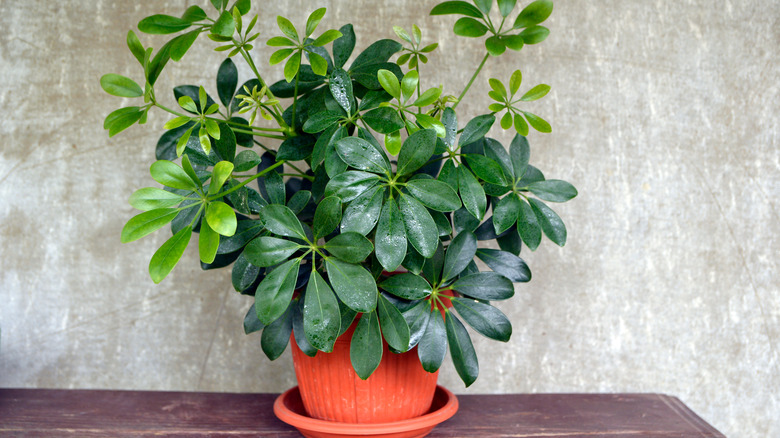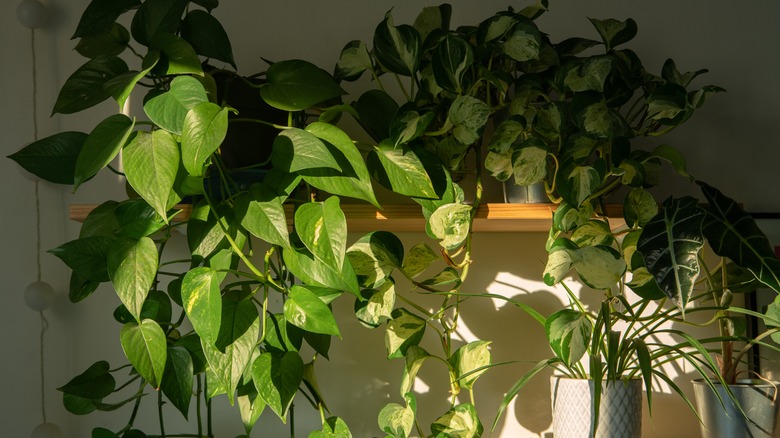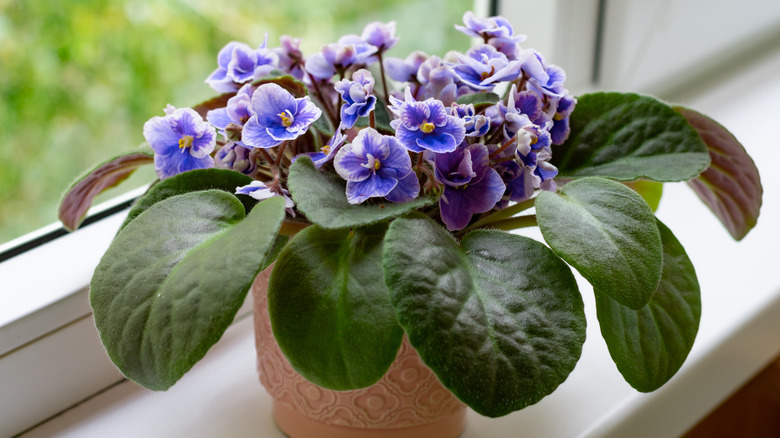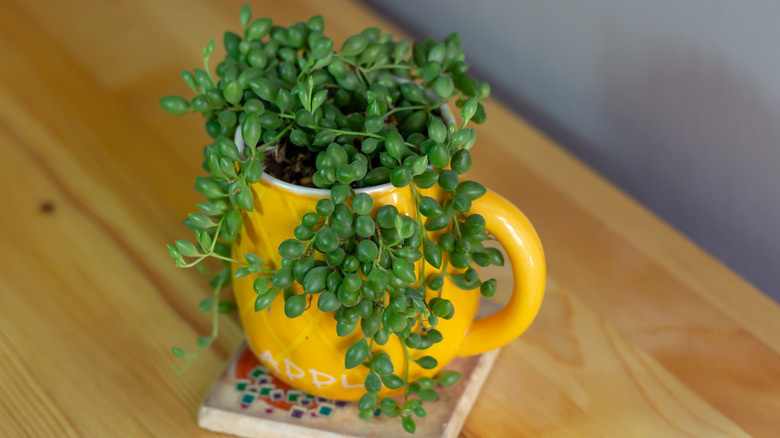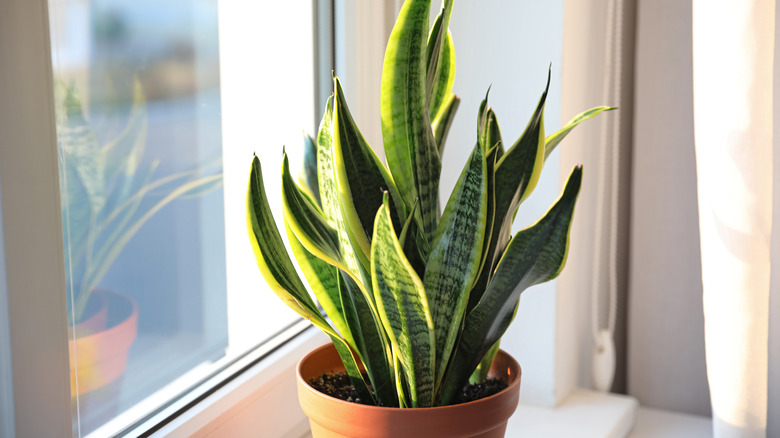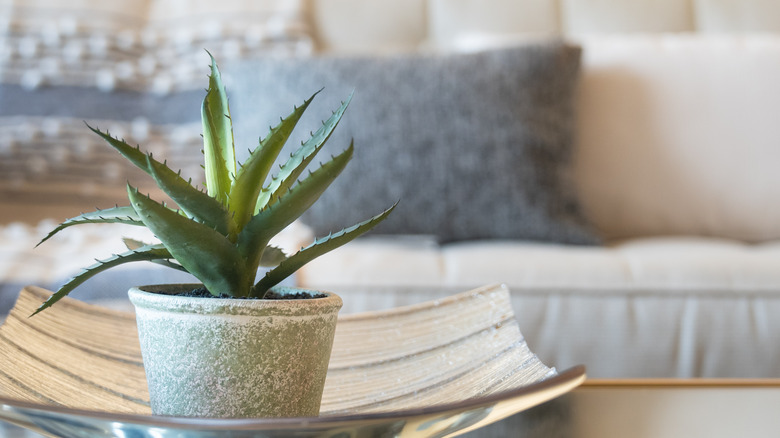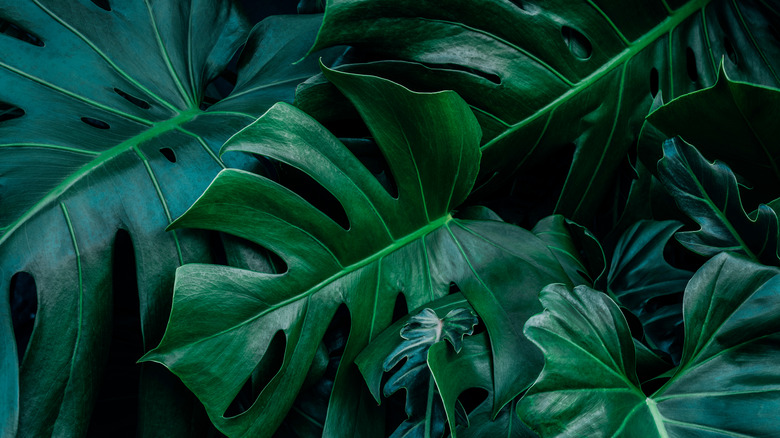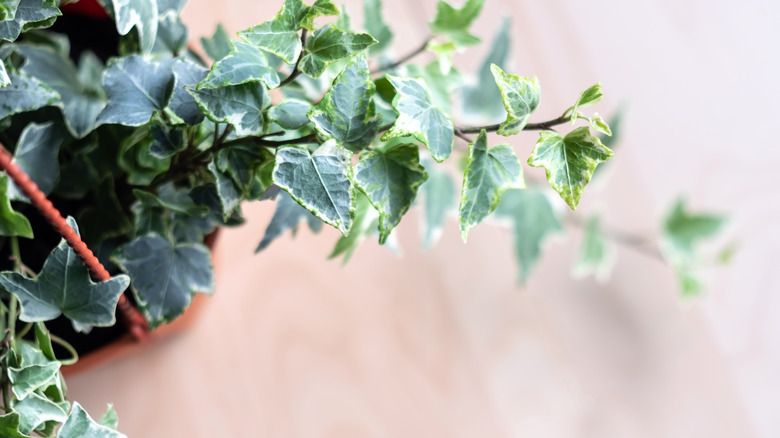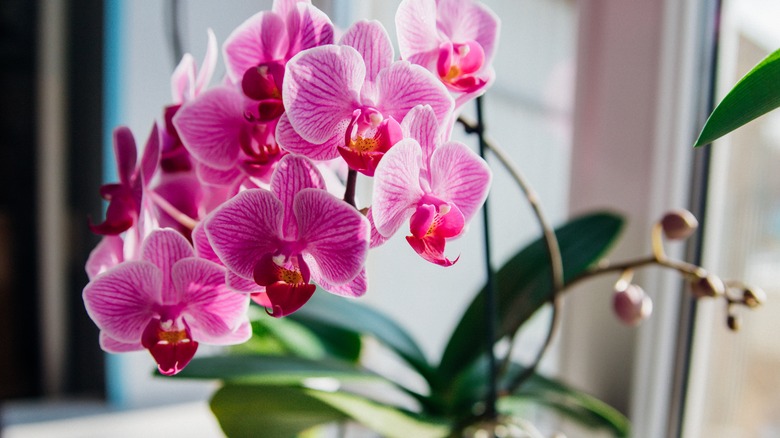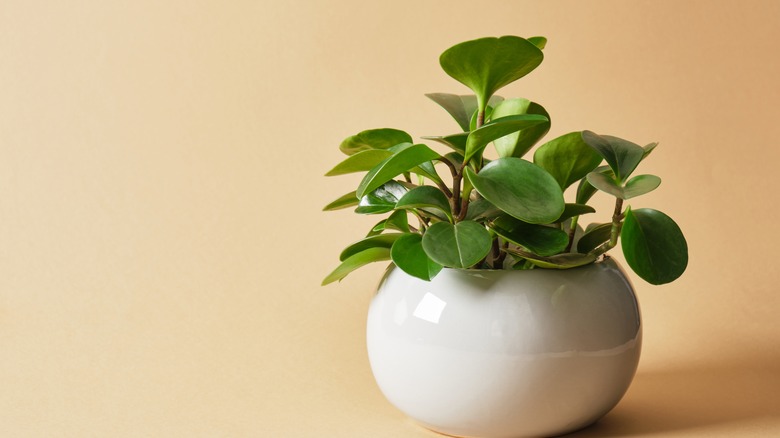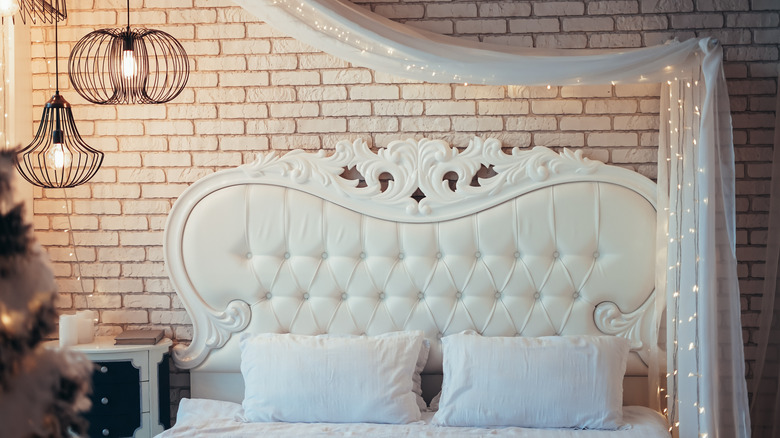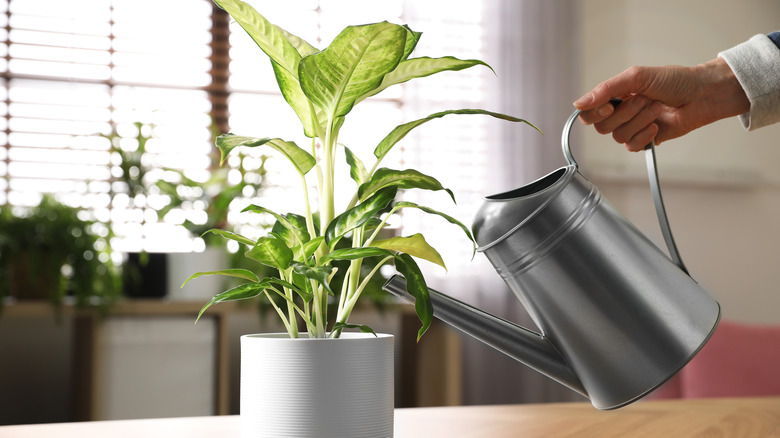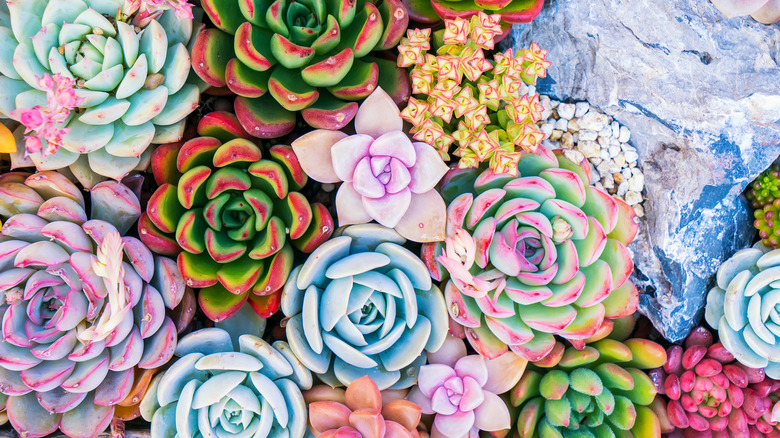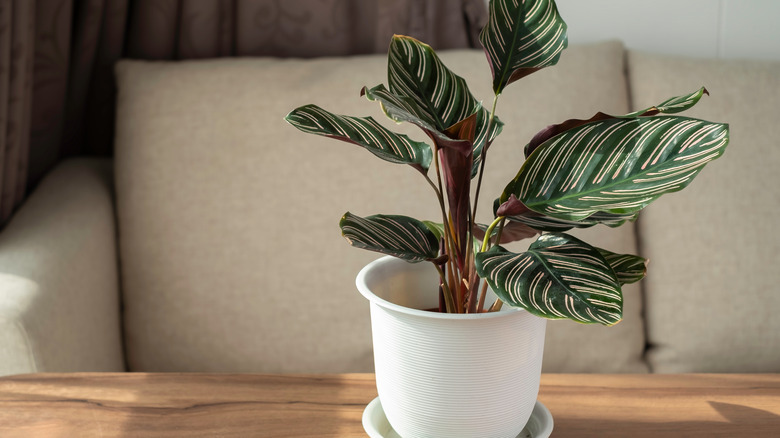The Perfect Plant For Your Style
If you've got an eye for interior design, you might also have a green thumb, a skillset that is bound to create beautifully curated, stylish spaces. Aside from knowing how to grow houseplants, you'll need to know how to choose the perfect plant for your decor style. While most of the time this is totally based on personal preference, it's also true that certain plants just work better in certain interiors, either due to the style of the space, the era it represents, or both.
Contemporary style, for example, focuses on space rather than things, according to The Spruce, where clean lines and interesting textures are prioritized and neutrals are encouraged. For plants that work well with the space, it's best to choose ones that blend in with this aesthetic while also being low-maintenance. Peace lilies are one of the best low-maintenance indoor plants, as noted by Forbes, since they tolerate most lighting conditions, don't need a lot of attention, and will even let you know (via drooping leaves) when it's time to water. They work beautifully with a contemporary interior, where their calming balance of graceful, dark green leaves and cream-colored flowers evoke a sense of peace. Keeping that in mind, here is the perfect plant according to your interior design style.
Standout fan Plants for art deco decor
Though items from this time period are seen as relics, the art deco style has been iconic since its influence began. There are certain defining characteristics, which The Spruce highlights as bold geometric patterns, elaborate lighting features, innovative furniture designs, and perhaps an overuse of metallic finishes. When combined into a space, all of these aspects give the room a vintage yet classic feel. With such a specified look, it might seem impossible to find greenery that fits in a look that is decades past, but be assured this is simpler than it seems.
The Chinese fan palm fits perfectly into this style, as its tall height and starburst-like shaped palms appear very grand and dramatic, according to Plant the Future, which works perfectly with key features of this style. Chinese fan palm is also pet friendly and fairly low-maintenance, just requiring bright somewhat shaded light, easily attainable in an Art Deco-inspired space.
The dwarf umbrella tree plant presents a similar aesthetic, but with more rounded edges on its leaves. Both the dwarf umbrella and Chinese fan palm prefer warmer temperatures, though Architecture Lab recommends more shaded light for the dwarf umbrella tree. This works especially well for darker toned Art Deco rooms, those in moodier jewel tones highlighted by metallic detailing.
A pothos for boho
Bohemian, or boho, decor has shifted considerably since its beginnings. Still, it is most commonly known as having a large resurgence in the '60s and '70s, as hippies and free love advocates adopted the style largely as their own. Features of bohemian design are based on remaining relaxed and personal, as noted by Vevano Home, very much reflective of the homeowner and based on self-expression. Regarding plants, houseplant ownership also had a resurgence in the '70s, as cited by Leon & George. Many tried creating very jungle-like atmospheres using vining or trailing plants, particularly pothos. Not only is incorporating pothos into a boho design much like bringing a friend back home, pothos are very expressive with their long tendril growth.
For those looking to lean more into the self-expression aspect of boho design, a terrarium is the perfect way to display your favorite smaller, colorful plants. Also a part of houseplant culture in the '70s, terrariums and bottle gardens were exceptionally popular (via Sunset) and have found their place back in the fold of the 21st century. These personalized, biospheric gardens represent the essence of boho decor and reflect their owner's lifestyle.
Embrace the traditions of English decor with African violets
As stated by Decor Outdoor, there is an understated formality to the English design style. Overall this kind of decor framework focuses on details, big and small, and keeping with a traditional feel. Some examples of this would be a four poster bed with floral bedding, or perhaps glossy dark wood living room furniture accented by frilly pillows and a footstool.
For a style that is a bit more high-maintenance, while remaining classic, the African violet is an ideal choice. Though a bit picky about its water intake, this plant's blooms are the ideal, quaint style that fits with the English aesthetic. The easiest way to take care of African violets is to water from the bottom of the roots (via Gardening Know How). Placing its planter container inside a large pot with a more English-style exterior is a perfect way to fit it into the space. For a lower-maintenance plant that blooms seasonally, the Kalanchoe is another great choice, according to the Clemson University Cooperative Extension Service. Pink, red, orange, yellow, or white Kalanchoe blooms produce flowers in elegant little bunches, bringing the look of a charming English garden inside.
Eccentric plants for an eclectic style
Eclectic is just that ... eclectic. Verging on wild and a little chaotic, an eclectic style, when seen through a wider lens, achieves a strong balance between colors, textures, and overall vibe that, at first glance, might not seem like they should go together. Velvet with metallic accents and bold colors, or perhaps a largely monochromatic interior with bright pops of neon on multiple surfaces. This style embraces fun patterns and unique shapes, and as Decor Aid points out, is all about experimentation, which gives the designer the freedom to have fun.
The anthurium and string of pearls can be described as playful, which fits perfectly with the eclectic style. Anthurium is normally a particular plant with a detailed list of needs, especially if you want it to bloom (via Smart Garden Guide). The string of pearls plant is a mostly easy-care plant, according to The Spruce, but it needs plenty of light, so if you have a bright window in your home, it would be the perfect fit. Its quirky shape will add the perfect touch of visual texture to complement an eclectic room.
Bring a snake plant into your Exploration-style home
An offshoot of British Colonial style, the Exploration style of design is a fun, travel-focused design aesthetic. These pieces, according to Decor Outdoor, have a vintage flair to them and emphasize Old World exploration methods of travel, from worn maps and globes to modular furniture that can easily be set up or packed away quickly. This aesthetic no doubt calls upon a deep sense of wanderlust and those who lean into it want features that are out of the norm, but not too difficult to collect and maintain.
Two plants that would fit well with this style are a bird's nest fern and, every beginner's favorite, the snake plant. Forbes notes that both of these are some of the best, easiest indoor plants to grow, and, if you have pets, the bird's nest fern is a safe, non-toxic option. Each variety is eye-catching — the snake plant with a fun zig-zag and stripe appearance, and the fern with its wavy, arching leaves. Both plants are perfect for a style that says "always out the door, onto the next adventure!"
Keep some aloe in your farmhouse
Farmhouse style has become a favorite amongst homeowners and interior decorators alike, and with good reason. Its balanced combination of contemporary and rustic stylings creates a warm yet clean environment that is easily achieved. Good Housekeeping notes some of the easiest ways to bring the farmhouse style to life in your own home include incorporating wood paneling to bring in a rustic warmth, making the most of natural lighting, and blending simple yet iconic textures with different furniture pieces, including wicker, cotton, and linen.
The farmhouse style inspires feelings of comfort and well-being, partly due to its simple, homey, and salt-of-the-earth aesthetic. Keeping an aloe vera plant in this space is not only an additional green element, but aloe is very useful in the home for skincare and even for consumption, according to Almanac. This plant just needs plenty of bright, indirect sunlight, or even artificial light. A weeping fig tree is also a great addition. A slow grower, this plant does best if kept in one spot, perfect to use as an anchor for the room. It also appreciates partially shaded light (via House Plant Expert) and when placed, it's like having a small tree inside your home, bringing the outdoors inside.
Give your Gothic style a touch of green
Modern versions of Gothic style thrive on moody palettes and dramatic fixtures. As Impressive Interior Design notes, this is not the style for those who prefer their things understated. For those eager to take the plunge into the dark and unknown, this style gives as much as it takes in terms of possibilities. If you like to accessorize through textures, pick regal-looking fabrics for your curtains, pillows, and furniture. If Gothic architecture is more your vibe, highlight detailed finishes or play the archways or doorways of the room or home. Another way to accent a Gothic space is surprisingly with plants; Gothic doesn't mean lifeless.
One iconic plant you can choose to play up your gothic space is Monstera delicioso, known colloquially as the "swiss cheese" plant or split-leaf philodendron, according to The Spruce. These almost-architectural tropical plants can grow quite tall and are the perfect touch of green to include in these types of stylized spaces. Its flair for the dramatic will complement the space, and its height can enhance the look of your more Gothic pieces. Another fun choice is the Zamioculcas zamiifolia, or the ZZ plant. Certain varieties of this plant sprout new leaves that are a bright, vibrant shade of green, but will eventually settle into a dark, almost black color, according to Gardenista.
Cover your cottage-style room in ivy
Simplistic, cozy, almost adorable, the cottage design style of living is a highly popular trend at the moment. It's a perfect companion to many other styles and can easily help you achieve a comfortable, cozy feel in your space. While this is a fairly relaxed style, a few hallmark details are needed to achieve the look. For example, Kerrie Kelly of the American Society of Interior Designers tells HGTV to add, "plenty of pattern, painted furniture, and weathered finishes, paired with baskets, natural-fiber rugs, and a garden palette."
Those looking to decorate will no doubt want to include some greenery in this type of space. English ivy is an ideal indoor plant to incorporate; ivy practically wraps you in a sense of coziness, and it brings out visions of an ivy-covered cottage in the English countryside. It's a calming accent to the neutral or colored accents, whichever you prefer in your cottage style, and its vining growth habit can soften shelves and other areas. But don't worry if it starts growing too long; English ivy can easily be pruned back, according to Gardening Etc. Pilea peperomioides is another ideal choice as its circular disc-like leaves are cohesive with the style's overall softness. This plant is also easy to propagate (via Gardeners' World), which means you can have these charming little plants all over the space to bring a cohesive, comfortable feeling.
Memphis means color ... and orchids
Memphis style, as Hommes Studio describes, transformed from just a postmodern style into a unique collaboration of design traits pulled from everything from art deco to pop art, and just about everything in between. If your decor or ideal style leans toward the Memphis style of design, odds are you're fearless when it comes to clashing and matching colors and overall styles. To complete the look, you should have plants that match this energy, and might also require a little bravery to own.
Orchids, a popular houseplant since the 1990s, are a beautiful addition to any space. Though brought to popularity during a decade where minimalism prevailed, their variety of colors and interesting shaped petals will absolutely add a creative edge to your already creative aesthetic. They can be a bit tricky to grow, though Phaeleonopsis types are the most forgiving, according to The Sill. Asparagus ferns also lie a little on the wild side, and have bushy forms and lacy foliage, according to Better Homes and Gardens. This textural interest is perfect for a Memphis style interior.
Minimalistic spaces require low maintenance plants
On quite the opposite spectrum, the essence of minimalist decor is that the spaces are calming and uncluttered. As Sharon Blaustein, principal designer at B Interior LLC, tells Elle Decor, this style thrives on the uncluttered and helps to accentuate the architectural features of a space. She also notes that color is generally used as an accent against a neutral backdrop.
The money tree plant is one of the best indoor plants to use in Feng Shui, according to Women's Health, which in itself is a style that focuses on finding the balance and harmony of a space (via Mindbodygreen). Not only is the shape and aura of the plant a calming presence, but the care of a money tree is exceptionally easy; oftentimes watering once a week with an ice cube worth of water is all it needs.
Another great option is the Peperomia obtusifolia or baby rubber plant, which the National Garden Bureau voted as 2022's Houseplant of the Year. This plant is quaint in size and can be found in a few color varieties, perfect for whichever pop of color you'd like to add to your minimalistic space. Its thicker, glossy leaves are beautiful, and the plant itself requires minimal watering. A perfect little plant for a minimal style.
Plants to accessorize a neoclassical look
Neoclassical interior design boasts accents and the ability to elegantly accessorize your spaces, all in order to meld ornate traditional themes with a modern twist. As Vogue notes, there are a few ways to bring this style into your spaces, from utilizing muted color palettes with pops of bolder furniture or finishes, and keeping luxury in mind. Matching like colors while mixing textiles and textures gives a room the sense of luxury and depth that are hallmarks of neoclassical style.
With such dramatic decor, the perfect plants for this space would actually do the opposite — add a simple touch so the grander decor can speak for itself. Plants like these include 'Nana' Juniper and cast iron plants, low maintenance greenery that emphasize your decor in a simple way. The juniper plant especially is an ideal plant for this type of space. Its roots are long and require a taller container for room to grow, according to Country Living, ideally, a tall, narrow, or pillar-like container. For neoclassical interiors, this could work beautifully with a tall detailed vase or cylindrical vessel. The cast iron plant is pretty resistant and is a great low light option, perfect for heavily curtained rooms or areas with lots of shade (via House Beautiful). Its larger, curved leaves also add plenty of color and texture to a space.
Putting the green thumb to soft industrial design
Soft industrial aesthetic embraces a room's bare form, from exposed vents or beams to crafted items like a steel frame and wooden shelf bookcase. This style plays up the practice of mixing the hard and soft, metal fixtures with soft linen drapes, or as Schlage proposes, mixing crisp edges with curves.
Choosing an aesthetic like this means leaning toward the simplistic side of style, but with an authentic, almost earnest personality. To play into the space with this in mind, some greenery that would work well is a silver satin plant, as it fits this style well with its cooler-toned color and interesting leaf design (via House Beautiful). However, for something simple that adds a bit more flair, Dieffenbachia is a good choice. As noted by Costa Farms, this plant, because it grows upright, takes up a good amount of vertical space, ideal in a soft industrial design layout that prefers bare or exposed walls.
Add succulents to your transitional space
The beauty of transitional spaces is that, like eclectic styles, this style thrives on evolving with your life and your tastes, as well keeping style restrictions to a minimum. As Renee DiSanto, co-founder of Park & Oak Interior Design, tells Apartment Therapy, "at its core, transitional style is a measured balance of various characteristics of traditional and modern design."
Keeping things both modern and traditional is even simpler when it comes to your plant life. There are many variations of Chinese evergreen that add a little spice to your home, but that level of spice is up to you. Not only does this plant grow beautiful, uniquely speckled leaves, but once it reaches maturity it will bloom in the summer (via House Plants Expert). Succulents as well are a beginner gardener's best friend for indoor spaces, and the ability to choose what would fit your collective aesthetic is even easier. Because of their small to medium size, they're easy to move around, enabling the flexibility that this decor style calls for. They're also easy to grow, though most need bright light and you'll need to avoid overwatering them (via Good Housekeeping).
Shabby chic's understated elegance
The shabby chic style has a certain understated elegance as it embraces softer tones and a mix of vintage and new, with a slightly feminine energy. Another unique feature of this style is its use of showcasing the wear of pieces, noted by the Decoist — the lovely patina on antique accent items or the chipping paint on a coffee table.
With these elements in mind, there are several plant options that will highlight the shabby chic aesthetic. Both the Calathea ornata and heart-leaf philodendron have an overall softer edge to them and are good plants to balance out a space, both with their color and cooler style. Though the Calathea can sometimes be the more sensitive of the two, it brings in great color for a room that has a softer outlook, with a rich purple color on the underside of its leaves, juxtaposed by light pink stripes on top of dark green on the top to balance (via Plant Care Today). The philodendron is ideal for its cute shape, adding to the energy of the space, and, according to Apartment Therapy, can even grow long if you're looking to swoop its tendrils into soft, draping curves.
